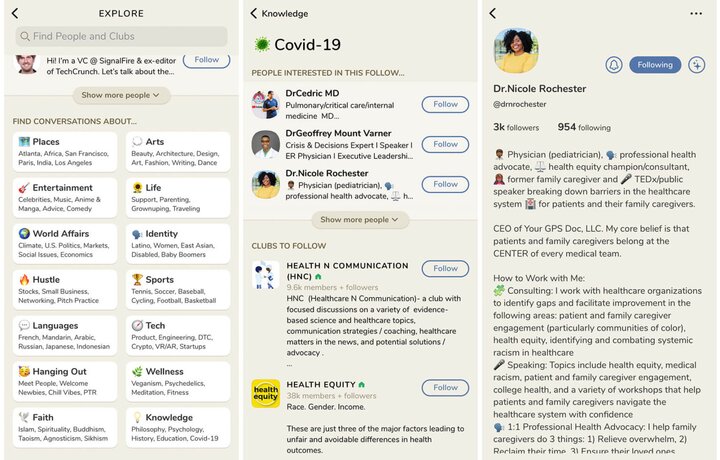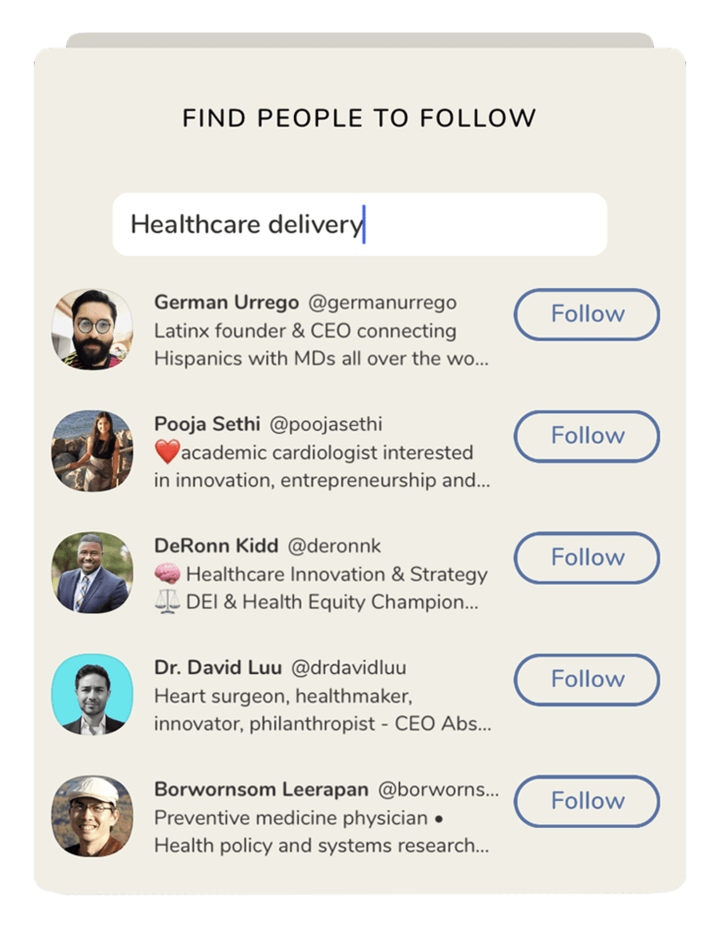News & Insights
News & Insights
BY BPD
Last year, WIRED said it well: “The future of social media is all talk. The year 2020 was all about giving people a voice online. Literally.” The pandemic forced many to substitute in-person interactions with virtual meetings, leading to widespread “Zoom fatigue.” This fatigue opened the door for audio-based social platforms like Clubhouse, Twitter Spaces, and the products in Facebook and Reddit‘s development queues.
While Clubhouse isn’t the only player in the space, it certainly claims the title of social audio pioneer. What’s all the buzz about? Here’s a rundown for health system marketers.
What is Clubhouse?
Clubhouse is a social platform for casual drop-in audio chats. The social networking app requires an invitation and is currently only available on iOS. It allows users to listen to live conversations and contribute to discussions.


For health brands and experts alike, Clubhouse presents the opportunity to start and participate in health-related conversations while connecting with health experts, influencers, and consumers.
Platform overview
With a fast-growing user base and big-betting investors, Clubhouse is catching like wildfire. Here’s a quick look at the platform from 10,000 feet.
- Clubhouse launched in the Silicon Valley during the summer of 2020, starting with 1,500 users
- Nearing another round of funding, Clubhouse anticipates a $4 billion valuation
- Is the 9th largest social network with 10 million users worldwide
- The platform is ranked as the 24th most popular social networking app in iOS Appstore (as of 5/7/21)
The app allows users to gather in audio chat rooms to discuss various topics — dealer’s choice. Rooms are divided into two groups: talkers and listeners. A moderator oversees discussions with the power to let someone chime in or to kick participants out. The platform’s mission is to provide a space for casual, drop-in audio conversations ranging from existing friends to subject matter experts to celebrities like Elon Musk, Drake, and more.
Clubhouse for healthcare marketing
There are countless healthcare conversation categories, dedicated clubs to follow, and scheduled audio chat rooms to join live on Clubhouse. Many physicians and medical professionals are on the app, sharing their knowledge in topics ranging from COVID-19 to healthcare, health equity, wellness, vaccinations, and beyond.
Healthcare content is popular on the app and has become a new way to engage with patients and other healthcare influencers. Healthcare providers advocate for and represent their affiliated hospitals and health systems while engaging with listeners human to human.
- Wellness category: includes medicine- and health-related topics, including clubs like Future of Healthcare (33K members), Health Equity (33k members), and Nurses Connect (12k members).
- Knowledge Category includes COVID-19 and the future of health topics with clubs spanning MedTech (63k members) and All Things COVID (31k members).
Health brands on clubhouse: Unlike other social platforms, brands do not typically create a presence on Clubhouse. Instead, it’s more common for an individual to represent a brand. For example, a physician could grow a following on a health system’s behalf. This individual focus could be an entryway for a robust influencer relations program as well.

- Cleveland Clinic had one of its leading physicians participate in a popular Clubhouse room to discuss his book on dieting. This physician served as a brand and employee advocate of Cleveland Clinic.
- Dr. John Patton of Cedars-Sinai is a Clubhouse influencer and moderator in the following healthcare rooms: @allthingscovid, @aspiringmds, @healthncommunications, @boardofblackphysicans, @medtech, @frontliners, @HCPmeet360
Clubhouse Healthcare Influencers: Individuals have started carving out an influential presence for themselves on Clubhouse separate from the institutions they serve. Some examples of growing followings include:
- Andy Mychkovsky (@healthcareandy), Host, Future of Healthcare Club on Clubhouse (6.3K followers)
- Hisham Yousif (@hishamyousif), Physician, Mount Sinai (20K followers)
- Dr. Dave Rabin (@dr.dave), Psychiatrist (26K followers)
- Jasmine El Nabli (@nutritionbeyond), RDN and club founder, Ask the Dietitian (17.5K followers)
- Dr. Shoshana Ungerleider, Internist and club founder, All Things Covid (14K followers)
Healthcare Experts as Clubhouse Guests: Additionally, many experts serve as guests in existing clubs. Like podcasting, guest blogs, or account takeovers, securing a guest speaker spot in a club can set the foundation for a strong Clubhouse presence. Examples of guests include:
- Dr. Michael Roizen, Head of Cleveland Clinic Wellness
- Sean Duffy, CEO of Omada Health
- Dr. Nicole Rochester, Pediatrician and CEO of Your GPS Doc

Clubhouse for healthcare marketing
For most healthcare organizations, Clubhouse is a channel to get to know and monitor for future opportunities. However, for B2B marketers and health systems seeking to promote particular service lines, Clubhouse may be more relevant than you think. Here are four ways to get started.
Mine Clubhouse for Insights: Listen to what’s being said around a particular topic in your industry. By listening, health system marketers can keep pace with industry trends while performing market research and connecting with their audiences.
- Example topics: women’s health, cardiology, COVID-19 vaccines, AI in healthcare
Build a Thought-Leadership Presence around One Topic: Share knowledge to reach key industry influencers. Examples:
- A physician joins COVID-19 conversations to answer vaccine FAQ’s
- A health tech product manager shares insights with the MedTech club (72K members)
- A nurse influencer leads a conversation about health equity for the Nurse Connect club (13K members) or Healthcare in Colour club (15K members)
Build your own community: Create branded clubs or rooms for an exclusive group of Clubhouse users. You can also center rooms and clubs around specific topics.
Collaborate with existing clubhouse influencers: Partner with creators or Clubhouse users, both in and outside the platform (i.e. on your existing social channels, for a live event, etc.)
Note that there are currently no paid advertising opportunities on the platform. Instead, Clubhouse’s monetization approach is to allow users to tip speakers through in-platform payments. And the platform plans to launch ticketed events and paid subscriptions in the future.
Like any new venture, these Clubhouse “pros” are balanced by “cons.” Here are a few negatives to the platform to familiarize yourself with.
- Reach limitations: While many rooms reach thousands of listeners, this kind of scale is typically reserved for the biggest celebrities. The average room may garner a hundred listeners or less.
- Reporting challenges: There are few metrics for brands to gauge success. As Clubhouse grows, we expect a maturation of its metrics. KPIs are currently limited to:
- Followers
- Room attendance
- Sentiment
- Word-of-mouth; buzz created by Clubhouse presence
- Creator-driven app: Clubhouse is not intended for brands but for individuals, forcing brands to use the platform creatively. FiercePharma advises health brands to use “brought to you by” formats for rooms or clubs.
Getting Started
With investors and big tech vying for their piece of the social audio pie, audio-first social media is here for the long haul. Not only will social audio become a mainstay for social marketing, but it’s also likely to merge with podcasts and other existing audio formats.
Our advice: Don’t wait to dip your toe into social marketing. Even if all you do today is secure an invitation to Clubhouse or start listening to content, it’s a crucial first step in claiming long-term mindshare in today’s increasingly competitive healthcare industry.
Related Blog Posts
Stay in Touch
Stay in Touch
Receive our updates, industry news and insights.


